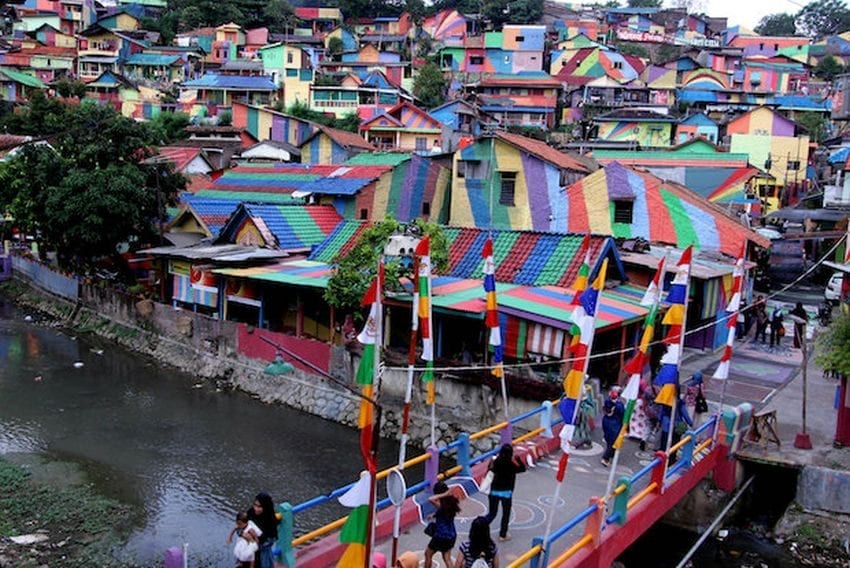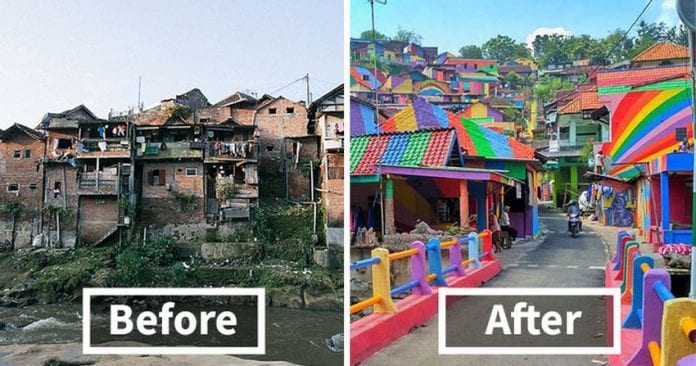Indonesian government decided to invest around US$29,000 in order to transform Kampung Pelangi’s slum in South Semarang into a creative village and thus offers an alternative solution to the local housing crisis. The village Kampung Pelangi literally translates to the Rainbow Village, and it finally got the overhaul it deserves, although no-one actually expected that from the government.

Turning this community into a creative project is beneficial for all, and it was a part of the government’s initiative to attract more visitors and tourists. However, the idea comes from Slamet Widodo, a junior high school principal and the government simply had to accept this idea. Once the makeover ended, the village was open to the public, achieving an immediate success and becoming an iconic tourism spot.
Thanks to the internet this phenomenon spread around like wildfire and more than 200 homes painted in rainbow stripes became so popular on Instagram and other social networks. Inspired by this successful project, the government plans to do a lot more of these, and they plan to build more homes in the future. This is a great 180 degrees turn, and instead of eliminating and demolishing slums, the government will from now on try to improve the standard of living in them.

Many people have believed that eviction is the only solution when it comes to slums such as these, where poor living conditions and lack of education rule, but it appears that this is not the case. There are numerous poor settlements around the world in which people need to defy authorities who are often trying to demolish dilapidated houses and buildings and build something more beautiful instead.
Nigeria is the perfect example, and more than 30,000 settlements in the city of Lagos were literally destroyed, and people who lived there were forced to leave their homes and go to some other place. This also happens in India whose government promised to make Mumbai slum-free by 2024.
People are starting to combat this global issue of demolishing slums and recently a landmark legal case has been launched to oppose the existing constitutional law in Indonesia which allows the slum removal. The traditional solution for years has been to eradicate the areas, leaving the people homeless and in search for new homes. Now, the government promises that these people will be relocated into new houses, and they simply need to accept that, but this is often a misconception, and the people are unlikely to move.
In most cases, the slum dwellers are satisfied with their living condition, and we need to understand that this is their home and they are sometimes unwilling to leave for a formal housing when given a chance. They can make their communities sustainable, and architects have thought of a model to show that urban areas and slums could coexist. What slum dwellers sometimes need is support from the state government.
The UN has recently adopted the New Urban Agenda which encourages countries all over the world to sustain slum areas and fulfill the rights of the residents here. Hopefully, the governments will no longer overlook the slums and they will try to figure out new ways to improve the living conditions instead of leaving people stranded. With this agenda, the slum dwellers have received more power in order to protect their communities from being run down, but it also pressures authorities to help people living there.
The establishment of Kampung Pelangi only shows us that improving the life in slums is possible. Sustainability can be achieved even though at times, it can be difficult to find how government’s initiatives can be combined with social purposes.
Do you like Kampung Pelangi?









